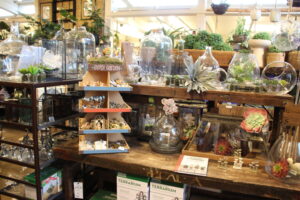Celebrate the Customer, the Merchandise, the Seasons
The Chalet Nursery, a 90-year-old nursery, garden center and landscaping business in Wilmette, Ill., “is not really known for its sales,” says buyer and merchandising manager John Hoerst.
Visitors to the Chalet are not greeted with tables and corners filled with “sale merchandise.” Merchandise that has been reduced in price is displayed for the benefit of the customer, with appeal and taste. As one customer noted, there is “no junky look” anywhere. Discreet signs indicate that certain select merchandise is available at a special value. Before deciding what to discount and how much discount to take, Hoerst says he tries to be creative when making decisions.
The Chalet built its reputation on celebrating the customer and creatively managing merchandise. Still, Hoerst admits, it’s hard to mark and move certain merchandise without a sale. The Chalet has two clearance “seasons,” July and December. But it’s the celebrations and creative merchandise management we’ll consider first.
Symbiotic Customer Service
In January, based on focus-group feedback, the Chalet launched the Chalet Valet Rewards Program, a voluntary benefits program for loyal Chalet customers. It has since grown to more than 10,000 members, according to communications director Maggie Zielinski. Every time a Chalet Valet member makes a purchase, that member earns points toward reward certificates, which arrive by mail twice a year. Members receive Chalet, a seasonal newsletter, featuring information about special events and the latest industry trends.
The inaugural spring and sum- mer issue of the newsletter introduced the Chalet’s Garden Faire 2007, a three-day event that celebrated the Chalet’s 90th birthday, and also featured an article about the anticipated arrival and emergence in the Chicago area of the periodical cicada. The latest holiday issue introduces events, holiday how-tos (including tips to build a perfect fireplace fire) and a feature about the Chalet’s role in a great Chicago tradition, decorating Macy’s Walnut Room for the holidays. Chalet Valet customers also receive mailings with special offers, discounts and invitations to special events, such as the Garden Faire, Holiday Preview Party and Open House Weekend, and lectures and classes.
Customers get their “perks,” and the Chalet builds its customer database. To encourage participation in the program, attendance at special events and promote sales, the Chalet offers regular classes at its Education Center and invites attendees to enroll, especially during special events.
The 2007 introduction of the Garden Faire at the end of April (replacing the traditional Perennial Faire in June) proved so successful that it will join the fall and winter holiday events as annual fixtures. There is a “special incentive” for purchases related to these events, Hoerst says. “We don’t like to call it a sale,” Hoerst explains, because these are “off sale times.”
Traditional Holiday Celebrations
The annual Holiday Preview Party, which typically occurs the second Thursday before Thanksgiving, will be extended to two days (Thursday and Friday, Nov. 8 and 9) this year to accommodate the larger Chalet Valet clientele. Customers can peruse and purchase the merchandise while enjoying the festive atmosphere.
The Chalet is “dressed” in its holiday finery, live harp music fills the diverse rooms, and beverages and hors d’oeuvres encourage a holiday spirit. Invited guests, including all Chalet Valet members, receive 20 percent off their entire purchase. Typically, Hoerst reports, “sales are 90-percent holiday items.”
In addition to the Holiday Preview Party, the Chalet will welcome customers and visitors to the Open House Weekend, Nov. 17 and 18, with live reindeer, face painting, popcorn and demonstrations. To help promote their pet products, the Chalet invites customers to march with their dogs in their holiday best in the Chalet’s Canine Corps, as part of the Chalet entry in the Village of Wilmette’s parade. The extended holiday mood and festivity will include several opportunities to visit Santa, a month-long stay of Santa’s reindeer, visits by internationally renowned ice sculptor Max Bollkman Zuleta and several holiday container workshops.
The Chalet takes advantage of special events as opportunities that feature the spirit of the celebration or the theme of your event. As the winter holiday season nears, Hoerst offers advice about how to delight both your customers and your bottom line. Using the same technique he applied to the overstocked silk flowers and ribbons, Hoerst has staff create wreaths that include slow-moving, overstocked ornaments, which make excellent additions to seasonal holiday wreaths, and offer the customer both fully designed and ready-to-enjoy decorations, as well as good ideas for creating their own.
Encouraging Customer Education
The Chalet recognizes that featuring staff expertise in education programs is a natural way to build a loyal, informed customer base. Since 1997, horticultural information specialist Jennifer Brennan has headed the education center, offered lectures and conducted workshops. Jennifer and other Chalet staff horticulturists present the majority of the programs, with guest experts occasionally joining the lineup. Brennan, formerly on the staff at the Chicago Botanic Garden, holds a degree in ornamental horticulture and is an Illinois Certified Nursery Professional.
Classes take place almost all year, “except during December and when people should be out in their gardens,” Hoerst says. These lectures and workshops offer a service to customers and the public. They also introduce attendees to the Chalet Center and its merchandise. More importantly, the educated gardener finds new products, possibilities and gardening worlds to explore. All of this opens doors for moving merchandise.
The Inevitable Sale
Finally, let’s consider the Chalet’s two seasonal sales, both of which reflect the personality of the garden center. The July sale usually takes place during the July 1-4 holiday and takes on the mode of yard sale. This sale is “not so much ‘clearance’ as seasonal reorganization,” Hoerst says. The merchandise includes “scratch and dent” items, one-of-a-kind remainders and seasonal merchandise from spring and early summer.
Moreover, during this event, when blooming perennials, such as bleeding hearts, or lilies, go out of bloom, they find their way to a few discreet “half-off” racks. Rather than put past-their-prime annuals and herbaceous plants on sale, the Chalet simply disposes of them. [Author’s note: Other independent retailers around the country may take this opportunity to share plants that are no longer marketable with community gardeners, nonprofit organizations or schools that might have young gardeners.]
The December sale begins Dec. 26 and spills into January, featuring holiday seasonal items marked down to move so there is no need to store it for an entire year, Hoerst says. Because there is new merchandise ready to be stocked, Hoerst explains, this sale period is also a “clean-up” and “inventory refresher” that is closely tied in with inventory.
This event brings in the customer who may not be a usual shopper but may need the bargains for incentive. Generally, Hoerst notes, customers “take out merchandise by the cartload.” This positive experience for newcomers also reinforces possibilities for return shopping visits, as the introduction has been successful.
By January, the Chalet features a real customer value opportunity. With spring merchandise ready for display, the question is: How do you move winter merchandise with minimum profit loss and a maximum customer excitement? Hoerst offers this simple solution: Bags.
The Chalet chooses the plastic bags. You can choose plastic or paper, or even inexpensive cloth bags. The size is up to you. Fill each bag with odds and ends, and seal it. There’s no switching of items within the bags. The value of the merchandise far exceeds the price charged, Hoerst emphasizes. The Chalet sells these grab bags for $2 each. You might choose another price.
“People consider the surprise packages treasures,” Hoerst says. “Some people come looking for more, but fortunately they are gone.”
In addition to moving the merchandise from your stock, you have cleared your floors and shelves of merchandise, and kept from having to inventory and replace the merchandise. Above all, you’ve made your customers happy and eager to attend the next celebration or garden class.
SIDEBAR
Stock-Moving Tips
Sales and discounts at the Chalet, according to Hoerst, are based more by category than by season. For example, there is no tree and shrub sale, because the Chalet typically overwinters these plant materials. However, in a given season, if excess fruit trees remain, Hoerst considers, “a discount might be given. It’s a question of inventory and volume at a given time.”
On a summer visit to the Chalet, shoppers would have seen a selection of unusual large Italian ceramic pots being offered at a discount. The pots had a good value in the first place, Hoerst says, because the Chalet buys direct from the Italian potters, with no middle-man expense, and the Chalet passes that value on to the customer. When traffic is slowing down, however, “You have to consider carefully,” Hoerst says. “If [you take markdowns] too soon, you lose the profit margin, but if you wait too long, you have to mark down even more.”
Another technique, particularly successful for selling plants, is to encourage multiple sales. Customers usually can use two plants (rather than two gift items), Hoerst suggests, so the Chalet offers a two-for-one value or quantity discounts, such as the value-packed opportunity available with annuals, offering them at $4.99 each or 12 for $3.99 each. The Chalet also offers year-round volume discounts on selected merchandise, such as bagged peat moss: 10 percent off for 10 or more of the same item.
With nongrowing merchandise, Hoerst applies a creative angle to increase sales without taking markdowns. You can see why this technique is so successful and apply the idea in your own center. Have an excess of silk flowers, ribbons or dried botanicals? Create wreaths or an arrangement to offer for sale. Slow-selling cache pots? Perhaps they are unusual, and customers can’t imagine them in their home.
“I had six high-value pots that wouldn’t move. So, I had the staff pot them up with succulents, a value of about $40. The pot was $80. We sold each for $250 in no time.” Hoerst says. “The value is based on intrinsics,” he explains. Presented in this way, all ready to enjoy and display, the customer found a greater value than in separate components.
Another way to move slow-moving containers or plants, according to Hoerst, is to, “pot up one with the ‘right’ materials or flowers. Place that one near the remaining containers for inspiration and they sell.” Hoerst explains that this is both a way to educate the customer and to inspire imagination. “An item is not necessarily a white elephant,” he explains, “but if no one shows [customers] what to do with it, it can sit on a shelf.”
Every garden center is popular when local groups seek donations for fundraisers, silent auctions, raffles, fairs, etc. The benefits of taking an active role in the community are well-documented (Lawn & Garden Retailer, March 2007). The Chalet takes advantage of these occasions to make contributed merchandise work for mutual benefit.
Hoerst suggests becoming allies with community organizations with philanthropic needs. The next time you are solicited for a donation, he suggests making a “perfect match.” For example, consider a slow-moving container and a slow-moving plant, each worth $50. “The two together make a terrific donation,” Hoerst says, “with its full value of $100, not the $25 you might be lucky to get in overstock inventory.”


















 Videos
Videos





